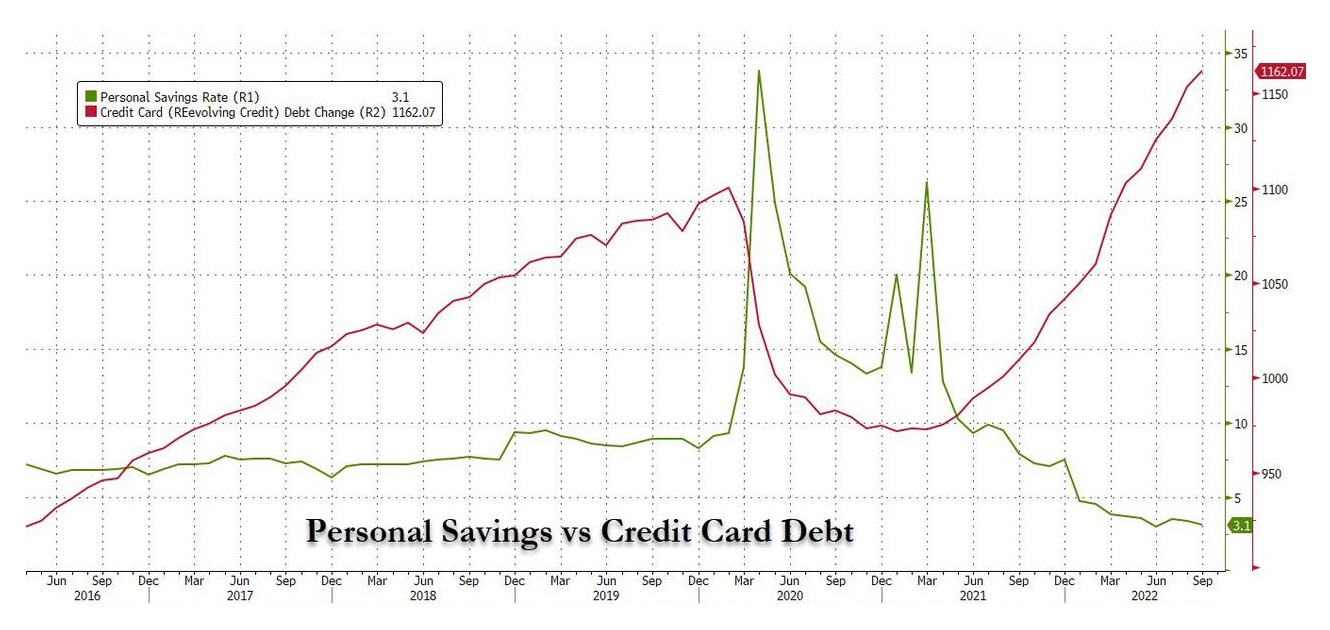Tis the season to be jolly? As the weather turns cold, Americans begin to think about Christmas and the year-end festivities. Black Friday, Cyber Monday, all the way to the last-minute Christmas shopping – will it be a good Christmas or a challenging one? Let’s examine the state of the consumer in America.
Tighter Fed policy is raising households’ interest-rate burden, leading to a rapid decline in excess savings and underscoring the likelihood that hawkishness has peaked. The pandemic rise in excess savings was probably the most rapid increase in wealth ever seen. A combination of a collapse in demand and huge government transfers led to an estimated peak of $2.3 trillion in excess savings being accumulated by the middle of 2021.
But after the feast comes the famine, and excess savings are being run down swiftly as inflation causes prices and interest rates to rise. These excess savings act as a buffer to a recession as they dampen the feedback loop of a decline in spending, leading to a fall in income, which means less spending, and so on.
The BEA (Bureau of Economic Analysis) defines the flow of savings = disposable personal income – consumption – other outlays. The personal savings rate is the difference between disposable income and consumption as a percentage of disposable income. The savings rate reached as high as 33% in the depths of the pandemic – a previously unimaginable level – but since then has collapsed to near all-time lows of 3.1%.
Meanwhile, card debt has already skyrocketed as consumers use credit card debt to alleviate the 40-year high inflation. See this in the chart below and learn more here.
 Savings are being increasingly stressed by rising debt repayments. In short, the consumer is tapped out for Christmas 2022 and is probably in the worse position in several decades.
Savings are being increasingly stressed by rising debt repayments. In short, the consumer is tapped out for Christmas 2022 and is probably in the worse position in several decades.
The Fed estimates that excess savings have dwindled to $1.7 trillion (as of mid-2022), a 26% drop in a year (see chart below). The stock of excess savings is likely to fall at an increasing pace as the lagged effects of rising interest rates bite. See this shocking drop in savings in the chart below.

The Redbook Index is a sales-weighted of year-over-year same-store sales growth in a sample of large US general merchandise retailers representing about 9,000 stores. A higher-than-expected number should be taken as positive to the USD, while a lower-than-expected number as negative. In the chart below, we can see retail sales are in a steady decline, providing more anecdotal evidence that the consumer is stressed.

After years of unabated growth, Black Friday and Cyber Monday online sales dipped for the first time last year, as many shops spread out deals over the entire Thanksgiving week or even further. “With early deals in October, consumers were not waiting around for discounts on big shopping days like Cyber Monday and Black Friday,” said Taylor Schreiner, Director at Adobe Digital Insights.
According to Adobe’s estimates, U.S. consumers spent $10.7 billion on Cyber Monday last year, slightly down from $10.8 billion in 2020. Black Friday spending also just missed the 2020 record, coming in at $8.9 billion in 2021 vs. $9.0 billion the year before. See this in the chart below and learn more here.

But all the above data is in the rearview mirror. What are some estimates for the 2022 Christmas season?
- Consulting giant PwC said in its holiday outlook report that consumers plan to spend an average of $1,430 on gifts, travel, and entertainment this holiday season. That’s actually down from the $1,447 they spent last year.
- KPMG’s survey of retail executives predicts holiday sales growth of just 4.2%, although flat to slightly negative when considering inflation.
- Bain & Company forecasts 7.5% growth in U.S. holiday sales. Bain says in its 2022 Holiday Shopping Outlook that merchants will face holiday growth challenges of tough comparable sales, soaring interest rates, declining disposable income, increasing consumer debt, and ongoing supply chain restraints.
In short, though the raw retail sales will be up, the growth rates are in decline. See this in the chart below and learn more here.

The takeaways of this data in terms of the state of the consumer is that – though Christmas 2022 will be a challenge for most consumers, it won’t be catastrophic. However, as the recession begins to accelerate in 2023, due to the Fed’s hawkish interest rate stance, beyond Christmas, it could get even more challenging for the American consumer.
Give us your thoughts on Christmas 2022. Will you be spending more, about the same or less relative to recent past years?
See more Chart of the Day posts.
If you found this article informative, please consider a small donation to our coffee cup to help support Conservative Journalism – or spread the word. Thank you.




